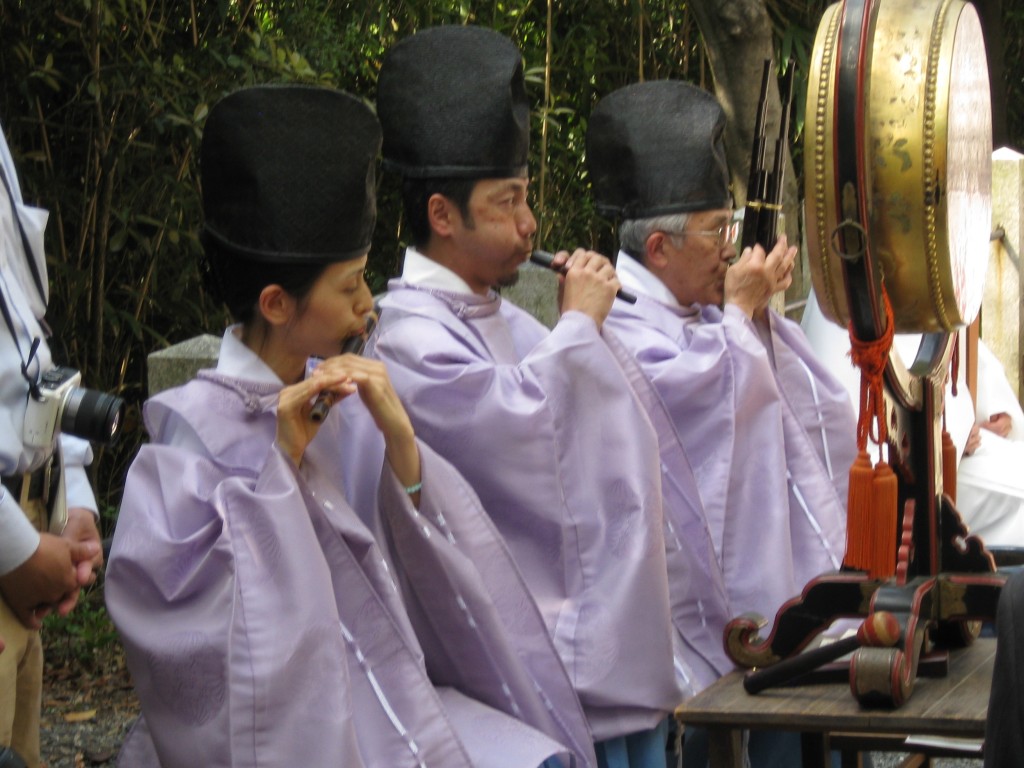
Since Heian times gagaku has been considered the music of the gods
A couple of years ago I went to a talk about sounds used for healing purposes which involved Tibetan singing bowls. That sounds affect the human psyche is obvious enough when one thinks of how certain kinds of music can move us to tears, yet other sounds induce panic and alarm. There are sounds too that can cause irritation or acute stress. Even human language itself can be affective, as the very different responses to French and German attest.
Musician Graham Ranft, presently studying the Ryuteki (the flute used in gagaku pictured above), has written in from Australia with some interesting observations he has come across regarding the use of sound in Shinto. These extend the notion of kotodama (word soul), by which certain words or sounds are thought to have magical properties (like the Middle Eastern word abracadabra).
The quotations below are drawn from “Japanese spirituality and music practice: Art as self-cultivation” by Koji Matsunobu.
The indigenous Japanese religions presented an animistic view of sound appreciation. It was believed that every sound bore a spirit, and people could be enlightened through any sound. Two important concepts regarding this view are otodamaho and ichion-jobutsu [the attainment of enlightenment through perfecting a single tone]…
The concept of otodamaho in Shinto is a method of purifying the body and mind
through the esoteric power of sound. A Japanese animist belief that was traditionally shared by people in ancient Japan explains that spiritual power resides in all sounds, including natural sound and spoken words. Otodamaho suggests that spiritual practitioners become engaged in a meditative process through the appreciation and embodiment of natural sounds, situating themselves in nature to become part of the universe.Yoshisane Tomokiyo (1888–1952), an institutor of a new sect of Shinto,
elaborates on the theory of spiritual sound based on the concept of otodamaho as follows: “Nothing is more magical than the spirit of sound. All things in this universe are caused by the spirit of sound. All lives flow with the spirit of sound”.To grasp this perspective, Tomokiyo recommends that one simply listen to a “sound.” Simply listen to a certain sound quietly and calm down. That’s all…. You do not have to listen to music. Listen to a certain unchangeable sound: the sound of a waterfall, the murmur of a brook, [the] sound of rain, the sound of waves, anything you like.
It turns out then that one reason why silence is golden is because it allows us to listen to the Sound of Nature. So drop out, turn off and tune in to those Good Vibrations the Beach Boys were singing about all those many years ago. And we look forward to further reports from Graham in his quest to pursue a Shinto spirituality through the resonance of sound.
********************************************************
To read more about the above concepts in regard to shakuhachi, please click on this page and scroll down to the text.
To read more about Sound Healing, please see this page.

The sounds of nature can have a healing effect

Thank you for this article. It’s very insightful. I play an instrument called ichigenkin. It has become a meditative process for me and If my schedule would allow I would play it more often than I do. I also start the day with norito. Of course, the words have their literal meanings, but the chanting has a calming and focusing effect not only for me but also for my spouse who sits by and simply listens. Days when I’m rushed and miss this practice seem more frenetic than if I take the time and give this morning gift to the kami, to my spouse and to myself.
I was able to get hold of the Matsunobu article via academia.edu – thanks for the info! Have you read Robert Carter’s book The Japanese Arts and Self-Cultivation? I originally got it for the chapter on Aikido, but found the chapters on gardening and pottery inspiring as well…
Thank you for the input. The Carter book looks most interesting and I shall try to get hold of a copy…
Read somewhere that the universe vibrates in the key of B-flat. Same pitch as the shakuhachi, I do believe.
The Indians built a whole cosmology around this, called Nada Brahma.
This post reminds me of what John has written in his Kyoto book about the refined sense of hearing in Heian Japan. During this period the elite listened to the chirping of crickets they kept in small cages. The insect music was accompanied by the flute. An intriguing image. Moving forward a few hundred years, a while ago I ordered a shakuhachi CD by Stan Richardson without really knowing much about the style of music. My main order was some Taiko drumming CDs. Since receiving the CDs I’ve listened to both the drumming and shakuhachi music many, many times. The drumming is very powerful and the shakuhachi music sublime. I hope to hear them both in person sometime. Thanks to the other Green Shinto followers for some useful leads in their comments.